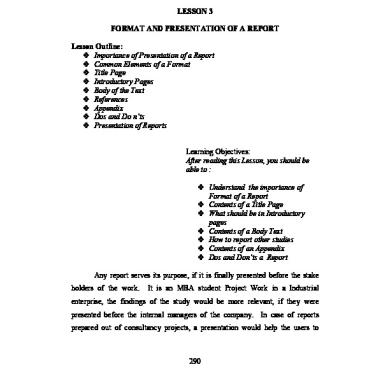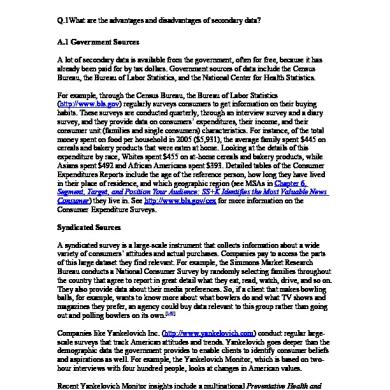Research Methodology (chapter 2)
This document was uploaded by user and they confirmed that they have the permission to share it. If you are author or own the copyright of this book, please report to us by using this DMCA report form. Report DMCA
Overview
Download & View Research Methodology (chapter 2) as PDF for free.
More details
- Words: 768
- Pages: 5
RESEARCH METHODOLOGY OBJECTIVE The objective of this study was to find out what are the policies and practices adopted by SCB because which it is know has the companies who have the strongest of HR in the global banking and financial market.
Scope of the study The scope of the study was to find some the key Area’s of improvement and to gain a practical knowledge about the operational and functional part of the human resource department of SCB.
Managerial usefulness of the study Being one the largest financial service and banking service providers, SCB always tries to find scope of improvement as the global environment is dynamic so the companies continuously need to evolve from the present stage to a much more higher level on which they gain maximum out put from the human capital they have with them.
Research Methodologies Scientific research Generally, research is understood to follow a certain structural process. Though step order may vary depending on the subject matter and researcher, the following steps are usually part of most formal research, both basic and applied: • • • • • • • •
Formation of the topic Hypothesis Conceptual definitions Operational definition Gathering of data Analysis of data Test, revising of hypothesis Conclusion, iteration if necessary
A common misunderstanding is that by this method a hypothesis can be proven or tested. Generally a hypothesis is used to make predictions that can be tested by observing the outcome of an experiment. If the outcome is inconsistent with the hypothesis, then the hypothesis is rejected. However, if the outcome is consistent with the hypothesis, the experiment is said to support the hypothesis. This careful language is used because researchers recognize that alternative hypotheses may also be consistent with the observations. In this sense, a hypothesis can never be proven, but rather only supported by surviving rounds of scientific testing and, eventually, becoming widely thought of as true (or better, predictive), but this is not the same as it having been proven. A useful hypothesis allows prediction and within the accuracy of observation of the time, the prediction will be verified. As the accuracy of observation improves with time, the hypothesis may no longer provide an accurate prediction. In this case a new hypothesis will arise to challenge the old, and to the extent that the new hypothesis makes more accurate predictions than the old, the new will supplant it.
Historical The historical method comprises the techniques and guidelines by which historians use historical sources and other evidence to research and then to write history. There are various history guidelines commonly used by historians in their work, under the headings of external criticism, internal criticism, and synthesis. This includes higher criticism and textual criticism. Though items may vary depending on the subject matter and researcher, the following concepts are usually part of most formal historical research: • • • • • •
Identification of origin date Evidence of localization Recognition of authorship Analysis of data Identification of integrity Attribution of credibility
Research methods The goal of the research process is to produce new knowledge, which takes three main forms:• • •
Exploratory research, which structures and identifies new problems Constructive research, which develops solutions to a problem Empirical research, which tests the feasibility of a solution using empirical evidence
The research room at the Public Library, an example of secondary research in progress. Research can also fall into two distinct types: • •
Primary research Secondary research
In social sciences and later in other disciplines, the following two research methods can be applied, depending on the properties of the subject matter and on the objective of the research: • •
Qualitative research Quantitative research
Research is often conducted using the hourglass model Structure of Research. The hourglass model starts with a broad spectrum for research, focusing in on the required information through the methodology of the project (like the neck of the hourglass), then expands the research in the form of discussion and results.
Methodology Adopted (historical) Here I have adopted historical method to carry our my research work in order to complete my project where I used both primary and secondary research in order to gain data from the employee and the hr department by working and coordinating with them at each levels so that I could have better understanding of the topic and the project.
LIMITATIONS • SINCE HISTORICAL DATA IS TAKEN INTO CONSIDERATION TO IT TENDS TO MAKE DIFFERENTIATE AT TIMES. • DIFFERENT VIEW POINTS AL DIFFERENT LEVELS IN THE ORGANISATION. • DUE TO DIVERSIVIED MARKET APPROACH GETTING TO ONE CONCLUSION WAS DIFFICULT.
Scope of the study The scope of the study was to find some the key Area’s of improvement and to gain a practical knowledge about the operational and functional part of the human resource department of SCB.
Managerial usefulness of the study Being one the largest financial service and banking service providers, SCB always tries to find scope of improvement as the global environment is dynamic so the companies continuously need to evolve from the present stage to a much more higher level on which they gain maximum out put from the human capital they have with them.
Research Methodologies Scientific research Generally, research is understood to follow a certain structural process. Though step order may vary depending on the subject matter and researcher, the following steps are usually part of most formal research, both basic and applied: • • • • • • • •
Formation of the topic Hypothesis Conceptual definitions Operational definition Gathering of data Analysis of data Test, revising of hypothesis Conclusion, iteration if necessary
A common misunderstanding is that by this method a hypothesis can be proven or tested. Generally a hypothesis is used to make predictions that can be tested by observing the outcome of an experiment. If the outcome is inconsistent with the hypothesis, then the hypothesis is rejected. However, if the outcome is consistent with the hypothesis, the experiment is said to support the hypothesis. This careful language is used because researchers recognize that alternative hypotheses may also be consistent with the observations. In this sense, a hypothesis can never be proven, but rather only supported by surviving rounds of scientific testing and, eventually, becoming widely thought of as true (or better, predictive), but this is not the same as it having been proven. A useful hypothesis allows prediction and within the accuracy of observation of the time, the prediction will be verified. As the accuracy of observation improves with time, the hypothesis may no longer provide an accurate prediction. In this case a new hypothesis will arise to challenge the old, and to the extent that the new hypothesis makes more accurate predictions than the old, the new will supplant it.
Historical The historical method comprises the techniques and guidelines by which historians use historical sources and other evidence to research and then to write history. There are various history guidelines commonly used by historians in their work, under the headings of external criticism, internal criticism, and synthesis. This includes higher criticism and textual criticism. Though items may vary depending on the subject matter and researcher, the following concepts are usually part of most formal historical research: • • • • • •
Identification of origin date Evidence of localization Recognition of authorship Analysis of data Identification of integrity Attribution of credibility
Research methods The goal of the research process is to produce new knowledge, which takes three main forms:• • •
Exploratory research, which structures and identifies new problems Constructive research, which develops solutions to a problem Empirical research, which tests the feasibility of a solution using empirical evidence
The research room at the Public Library, an example of secondary research in progress. Research can also fall into two distinct types: • •
Primary research Secondary research
In social sciences and later in other disciplines, the following two research methods can be applied, depending on the properties of the subject matter and on the objective of the research: • •
Qualitative research Quantitative research
Research is often conducted using the hourglass model Structure of Research. The hourglass model starts with a broad spectrum for research, focusing in on the required information through the methodology of the project (like the neck of the hourglass), then expands the research in the form of discussion and results.
Methodology Adopted (historical) Here I have adopted historical method to carry our my research work in order to complete my project where I used both primary and secondary research in order to gain data from the employee and the hr department by working and coordinating with them at each levels so that I could have better understanding of the topic and the project.
LIMITATIONS • SINCE HISTORICAL DATA IS TAKEN INTO CONSIDERATION TO IT TENDS TO MAKE DIFFERENTIATE AT TIMES. • DIFFERENT VIEW POINTS AL DIFFERENT LEVELS IN THE ORGANISATION. • DUE TO DIVERSIVIED MARKET APPROACH GETTING TO ONE CONCLUSION WAS DIFFICULT.
Related Documents

Research Methodology (chapter 2)
June 2020 10
Chapter Iii Research Methodology
May 2020 10
Research Methodology 2
November 2019 6
Research Methodology 2 Complete
June 2020 4
Research Methodology
November 2019 34